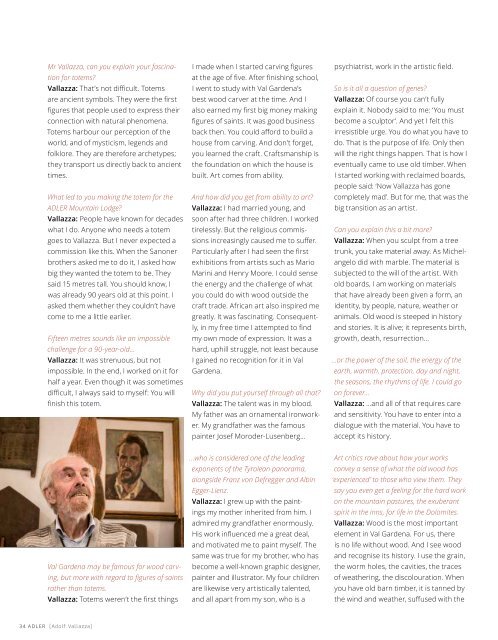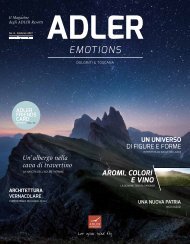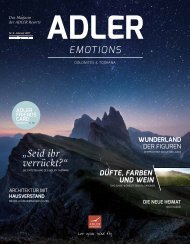Create successful ePaper yourself
Turn your PDF publications into a flip-book with our unique Google optimized e-Paper software.
Mr Vallazza, can you explain your fascination<br />
for totems?<br />
Vallazza: That’s not difficult. Totems<br />
are ancient symbols. They were the first<br />
figures that people used to express their<br />
connection with natural phenomena.<br />
Totems harbour our perception of the<br />
world, and of mysticism, legends and<br />
folklore. They are therefore archetypes;<br />
they transport us directly back to ancient<br />
times.<br />
What led to you making the totem for the<br />
<strong>ADLER</strong> Mountain Lodge?<br />
Vallazza: People have known for decades<br />
what I do. Anyone who needs a totem<br />
goes to Vallazza. But I never expected a<br />
commission like this. When the Sanoner<br />
brothers asked me to do it, I asked how<br />
big they wanted the totem to be. They<br />
said 15 metres tall. You should know, I<br />
was already 90 years old at this point. I<br />
asked them whether they couldn’t have<br />
come to me a little earlier.<br />
Fifteen metres sounds like an impossible<br />
challenge for a 90-year-old…<br />
Vallazza: It was strenuous, but not<br />
impossible. In the end, I worked on it for<br />
half a year. Even though it was sometimes<br />
difficult, I always said to myself: You will<br />
finish this totem.<br />
Val Gardena may be famous for wood carving,<br />
but more with regard to figures of saints<br />
rather than totems.<br />
Vallazza: Totems weren’t the first things<br />
I made when I started carving figures<br />
at the age of five. After finishing school,<br />
I went to study with Val Gardena’s<br />
best wood carver at the time. And I<br />
also earned my first big money making<br />
figures of saints. It was good business<br />
back then. You could afford to build a<br />
house from carving. And don’t forget,<br />
you learned the craft. Craftsmanship is<br />
the foundation on which the house is<br />
built. Art comes from ability.<br />
And how did you get from ability to art?<br />
Vallazza: I had married young, and<br />
soon after had three children. I worked<br />
tirelessly. But the religious commissions<br />
increasingly caused me to suffer.<br />
Particularly after I had seen the first<br />
exhibitions from artists such as Mario<br />
Marini and Henry Moore. I could sense<br />
the energy and the challenge of what<br />
you could do with wood outside the<br />
craft trade. African art also inspired me<br />
greatly. It was fascinating. Consequently,<br />
in my free time I attempted to find<br />
my own mode of expression. It was a<br />
hard, uphill struggle, not least because<br />
I gained no recognition for it in Val<br />
Gardena.<br />
Why did you put yourself through all that?<br />
Vallazza: The talent was in my blood.<br />
My father was an ornamental ironworker.<br />
My grandfather was the famous<br />
painter Josef Moroder-Lusenberg...<br />
…who is considered one of the leading<br />
exponents of the Tyrolean panorama,<br />
alongside Franz von Defregger and Albin<br />
Egger-Lienz.<br />
Vallazza: I grew up with the paintings<br />
my mother inherited from him. I<br />
admired my grandfather enormously.<br />
His work influenced me a great deal,<br />
and motivated me to paint myself. The<br />
same was true for my brother, who has<br />
become a well-known graphic designer,<br />
painter and illustrator. My four children<br />
are likewise very artistically talented,<br />
and all apart from my son, who is a<br />
psychiatrist, work in the artistic field.<br />
So is it all a question of genes?<br />
Vallazza: Of course you can’t fully<br />
explain it. Nobody said to me: ‘You must<br />
become a sculptor’. And yet I felt this<br />
irresistible urge. You do what you have to<br />
do. That is the purpose of life. Only then<br />
will the right things happen. That is how I<br />
eventually came to use old timber. When<br />
I started working with reclaimed boards,<br />
people said: ‘Now Vallazza has gone<br />
completely mad’. But for me, that was the<br />
big transition as an artist.<br />
Can you explain this a bit more?<br />
Vallazza: When you sculpt from a tree<br />
trunk, you take material away. As Michelangelo<br />
did with marble. The material is<br />
subjected to the will of the artist. With<br />
old boards, I am working on materials<br />
that have already been given a form, an<br />
identity, by people, nature, weather or<br />
animals. Old wood is steeped in history<br />
and stories. It is alive; it represents birth,<br />
growth, death, resurrection…<br />
…or the power of the soil, the energy of the<br />
earth, warmth, protection, day and night,<br />
the seasons, the rhythms of life. I could go<br />
on forever…<br />
Vallazza: …and all of that requires care<br />
and sensitivity. You have to enter into a<br />
dialogue with the material. You have to<br />
accept its history.<br />
Art critics rave about how your works<br />
convey a sense of what the old wood has<br />
‘experienced’ to those who view them. They<br />
say you even get a feeling for the hard work<br />
on the mountain pastures, the exuberant<br />
spirit in the inns, for life in the Dolomites.<br />
Vallazza: Wood is the most important<br />
element in Val Gardena. For us, there<br />
is no life without wood. And I see wood<br />
and recognise its history. I use the grain,<br />
the worm holes, the cavities, the traces<br />
of weathering, the discolouration. When<br />
you have old barn timber, it is tanned by<br />
the wind and weather, suffused with the<br />
sweat of the animals. It is scarred by<br />
hoof marks, nails, bore holes. In boards<br />
taken from the interior of a mountain<br />
farm parlour I even found several of the<br />
farmers’ teeth.<br />
You are considered the Giacometti of wood<br />
sculpture, the Picasso of the totem. You are<br />
renowned as an artist around the globe.<br />
Why did you never leave Ortisei?<br />
Vallazza: : I can only work here, in this<br />
building, in this studio, from where I<br />
have a view of the Sassolungo. The<br />
mountains always had a profound effect<br />
on me, even in my childhood. Even<br />
then I was so connected to the landscape<br />
that I never wanted to leave it. A<br />
fellow artist once offered me his studio<br />
in Milan. I couldn’t work there. I just<br />
couldn’t. Impossible. You will always find<br />
allusions to the mountains, their wild,<br />
pointed summits, and to their myths<br />
and legends in my sculptures, even in<br />
the thrones and totems.<br />
your work and planned a solo exhibition<br />
with you, couldn’t persuade you to leave<br />
South Tyrol?<br />
Vallazza: It is enough for my art to be<br />
shown all over the world. Deep down,<br />
I was always connected to the rural<br />
world of my valley. It was exactly the<br />
same for my grandfather. Painting was<br />
his life, wood is mine. For me, wood is<br />
everything: my soul, my heart, my mind,<br />
my history. Wood and I are one; we<br />
have become grafted together. It is like<br />
breathing.<br />
What makes you particularly proud?<br />
Vallazza: My large works. To be able to<br />
create these monumental artworks was<br />
the best thing in the world. The totem<br />
for the <strong>ADLER</strong> Mountain Lodge belongs<br />
in this category. Unfortunately, I am no<br />
longer able to create such large works<br />
of art. I can’t manage it physically.<br />
Should we worry that you are going to<br />
retire now?<br />
Vallazza: No, no. I’m a workaholic. Working<br />
has always brought me pleasure. I<br />
am far from done. I still have so much to<br />
learn. I always need to be going forward.<br />
Creativity is wonderful, and always<br />
needs motivation. That is my strength.<br />
My drawers are full of sketches. But I<br />
won’t be able to use them all. I would<br />
need to live to the age of 300 years for<br />
that.<br />
Adolf Vallazza<br />
in his atelier<br />
Adolf Vallazza<br />
is born in Ortisei on 22 September 1924.<br />
He attends the Gymnasien (grammar<br />
schools) in Merano and Bolzano.<br />
His studies with the sculptor Luis Insam-<br />
Tavella are interrupted in 1944 when he is<br />
conscripted for military service.<br />
After the war, Vallazza opens a wood<br />
carving studio and specialises in figures of<br />
saints and the stations of the cross.<br />
In 1953 he marries Renata Giovannini. The<br />
couple go on to have four children.<br />
His first exhibitions are held in 1958. The<br />
artisan becomes an artist. He creates<br />
his first big works for public buildings in<br />
Germany and Italy.<br />
The book ‘I Legni di Vallazza’ (Vallazza’s<br />
wooden works) is published in 1973. He<br />
undertakes work for private individuals and<br />
companies; renowned museums in Italy<br />
and abroad acquire his works.<br />
‘I totem di Vallazza’ (Vallazza’s totems) is<br />
produced between 1983 and 1984 together<br />
with photographer Mario De Biasi.<br />
In 1993, the artist has a formative<br />
encounter with the New York art critic<br />
and Guggenheim curator Fred Licht, who<br />
Vallazza deems to be one of the preeminent<br />
sculptors of his generation.<br />
34 <strong>ADLER</strong> [Adolf Vallazza] [Adolf Vallazza] <strong>ADLER</strong> 35







